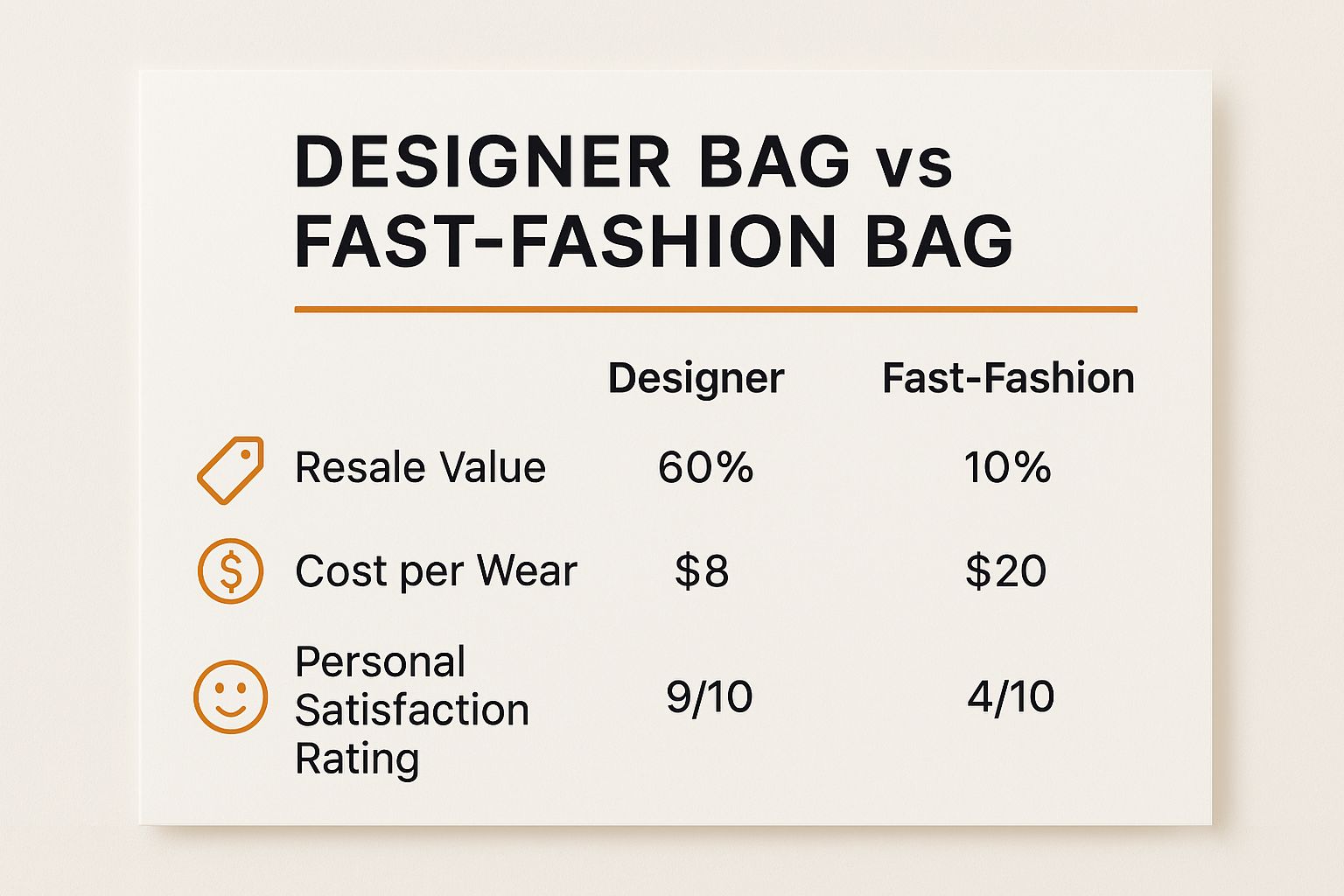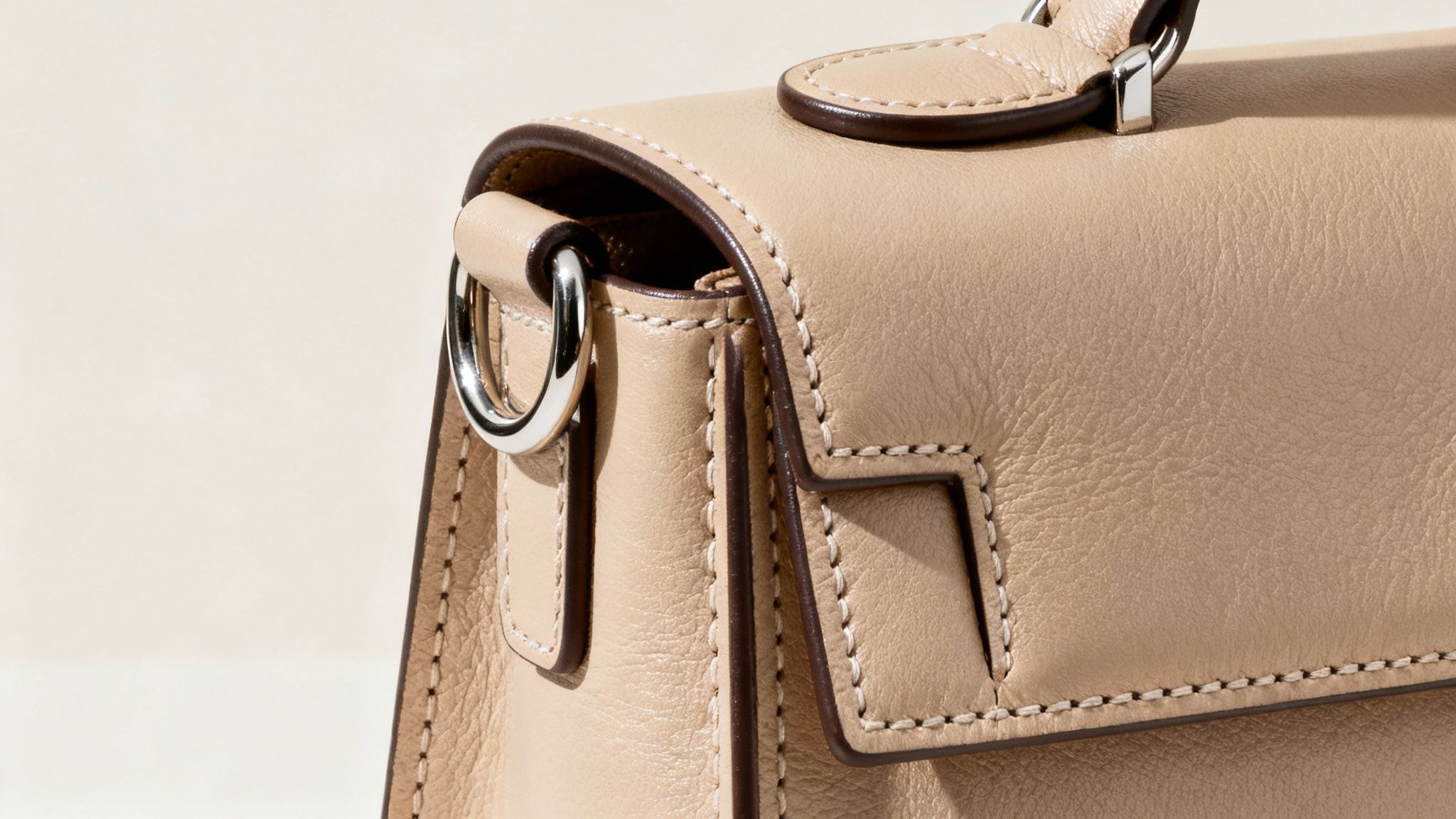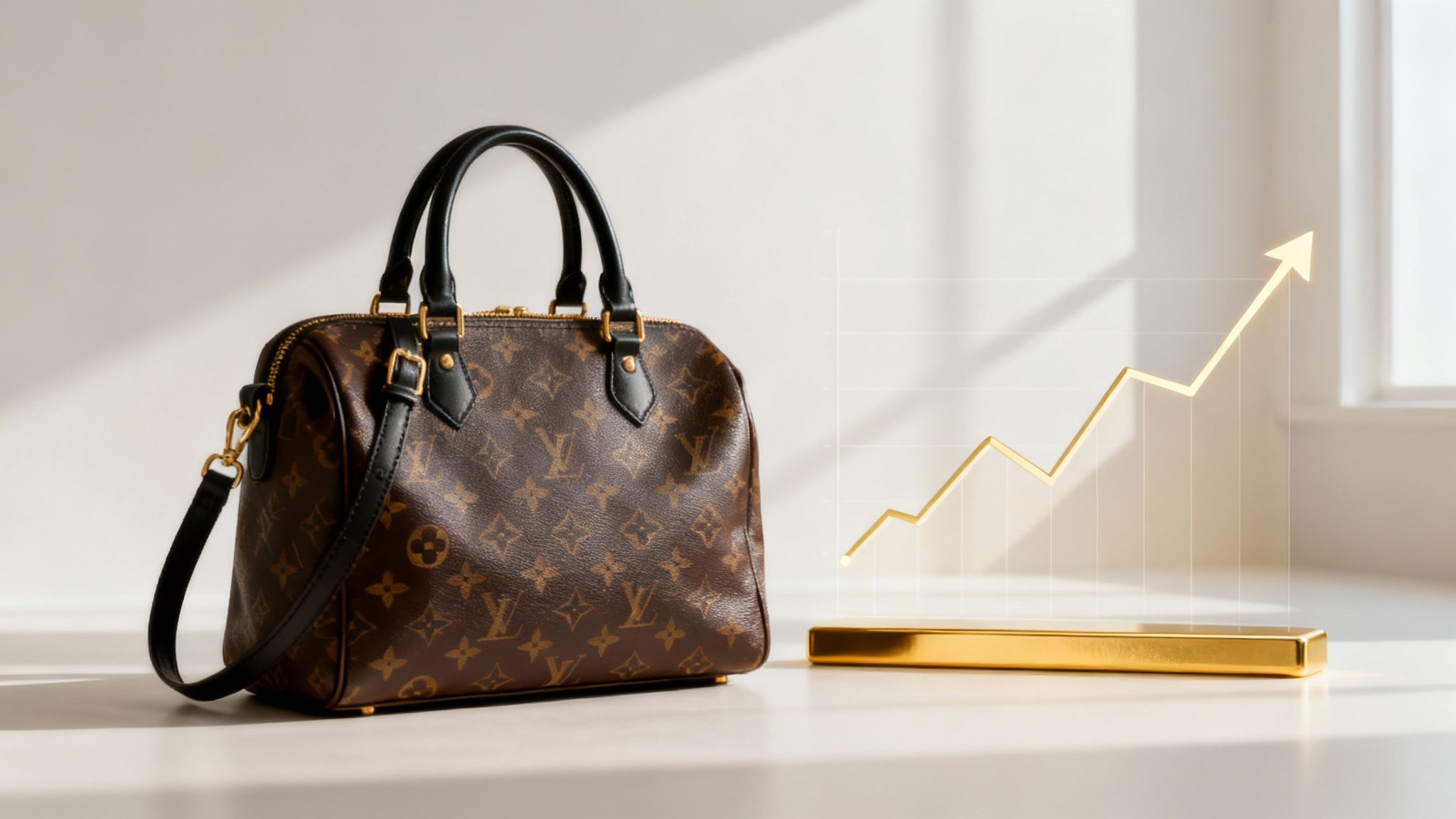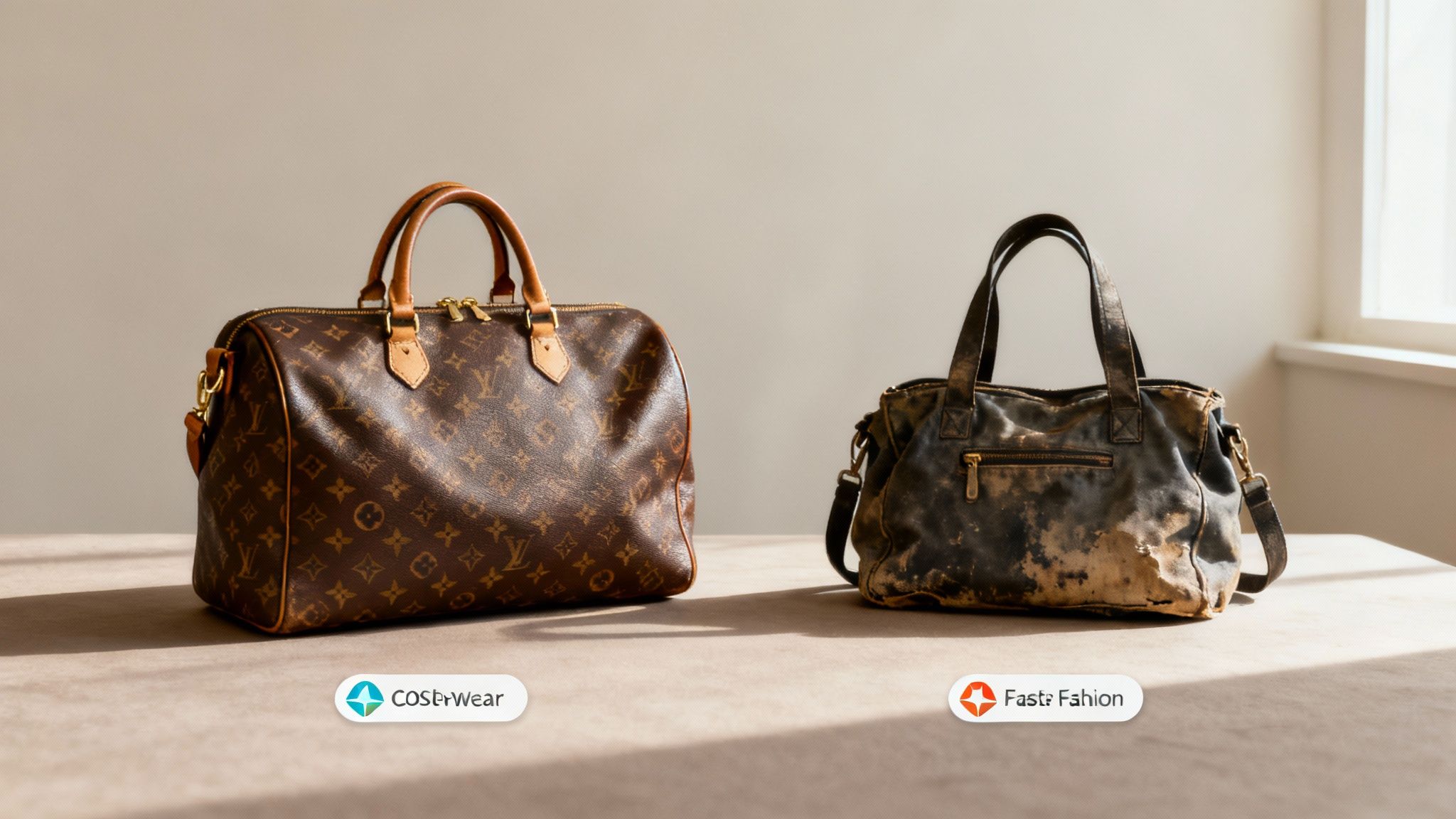Are Designer Bags Worth It? A Complete Investment Guide

So, you're wondering if a designer bag is really worth it. My answer is a firm yes, but maybe not for the reasons you’d expect. Forget the flashy logo for a second; this is about real, measurable value that you can see in your wallet and feel every day.
The Real Value of a Designer Bag
Looking at that price tag can be intimidating, I get it. But to figure out if a luxury handbag is a smart move, you have to think less like you're on a shopping spree and more like you're making a long-term investment. The whole idea of "worth" really comes down to three key things.
First, let's talk money. A well-chosen designer bag, especially an iconic one, can be a tangible asset. Unlike a cheap bag from a fast-fashion store that loses its value the second you walk out the door, many luxury bags hold a huge chunk of their original price on the resale market. Some of the really special or limited-edition ones can even go up in value.
Then there’s the practical side of things, what I like to call the cost per wear. It’s a simple little bit of math: divide the bag's price by the number of times you actually use it. A timeless, beautifully made designer piece you carry for a decade could easily end up costing you less per outing than a trendy bag you have to replace every single year. Suddenly, it’s not just a purchase; it's an investment in something that lasts.
Finally, and this is a big one, is how it makes you feel. A designer bag is an investment in your own personal style and confidence. There’s a unique joy in carrying something you saved for, something you truly love, and that feeling is a return on investment you just can't put a price on. It’s the finishing touch that pulls an outfit together, and often, it’s a way to mark a big moment in your life. Of course, when you invest in items like this, protecting them is key. Many people look into options like private client insurance for high-value assets to safeguard their collections.
This infographic breaks down exactly how a designer bag stacks up against a fast-fashion alternative when you look at the numbers.

Designer vs Fast Fashion A Quick Value Comparison
When you put them side-by-side, the long-term value proposition becomes crystal clear. It's not just about the initial sticker shock; it's about what you get for your money over the years.
| Metric | Typical Designer Bag | Typical Fast Fashion Bag |
|---|---|---|
| Upfront Cost | $1,500 - $5,000+ | $30 - $80 |
| Lifespan | 10+ years (often a lifetime) | 1-2 seasons |
| Resale Value | 50% - 110% of original price | Virtually $0 |
| Craftsmanship | Hand-stitched, premium leather | Machine-made, synthetic materials |
| Cost Per Wear (5 years) | Often less than $1 per wear | Can be higher due to frequent replacement |
The table really tells the story. While the initial hit to your bank account is much higher with a designer bag, the lasting quality, retained value, and sheer durability make it a smarter financial choice in the long run.
As we dive deeper into each of these ideas, you’ll get a much clearer picture of whether a designer bag is the right kind of investment for you.
What You Are Actually Paying For
When you see a four or five-figure price tag on a handbag, it's natural to think you're just paying for the logo. And yes, marketing and brand prestige are part of the equation, but a huge chunk of that cost comes from real, tangible quality that a fast-fashion bag just can't touch. To figure out if a designer bag is "worth it," you have to understand the difference between something mass-produced and something handcrafted to last.
It’s a bit like comparing a flat-pack particleboard bookshelf to a solid oak cabinet built by a master carpenter. They both hold books, sure. But one is designed to get you through a few years, while the other is built to be passed down through generations. The designer bag is that oak cabinet.

Superior Materials and Hardware
It all starts with the raw materials. Luxury houses are incredibly picky, often sourcing their leather from exclusive tanneries that have been perfecting their methods for centuries. These leathers aren't just chosen because they look perfect on day one, but for how they'll look years from now—developing a gorgeous, rich patina instead of cracking and peeling.
For instance, you'll often see iconic bags made from full-grain calfskin or incredibly soft lambskin, both known for being tough yet supple. If you want to dive deeper into what makes these materials the gold standard, you can learn more about what makes Italian leather so special. This dedication to quality goes all the way to the hardware; zippers, clasps, and protective feet are often plated with precious metals like palladium or gold to keep them from tarnishing and ensure they work perfectly for decades.
Meticulous Craftsmanship
After the materials comes the human touch: the sheer hours of skilled work that go into every single piece. A single designer bag can take anywhere from 18 to 48 hours to create, all put together by artisans who have spent years honing their craft.
This is the opposite of an assembly line. It’s a slow, careful process full of techniques that machines simply can't match for precision or durability.
- Hand-Stitching: Many famous bags use a saddle stitch, a classic technique using two needles to create a locking stitch. This means if one thread happens to break, the whole seam won’t unravel, keeping your bag structurally sound for years to come.
- Edge Painting: The raw edges of the leather are carefully painted, sanded, and sealed by hand, sometimes over and over again. This process protects the leather from fraying and gives the bag a clean, polished look.
- Pattern Matching: For bags with monograms or distinct patterns, artisans spend a ton of time making sure the design lines up perfectly across every seam and panel. It's a tiny detail that makes a huge difference, and it's almost always overlooked on cheaper bags.
The true cost of a designer bag isn't just in the logo; it's in the hours of an artisan's life, the quality of ethically sourced materials, and the promise of a product designed to outlive trends.
Ultimately, that high price reflects a completely different philosophy of making things. You're paying for a piece of functional art, where every last detail is thought out and executed to the highest possible standard. This is what gives a bag its longevity and is a huge reason why so many hold their value so well over time.
How Designer Bags Perform as Financial Assets
Let's switch gears for a moment. We've talked about craftsmanship and cost-per-wear, but what about looking at a designer bag through the lens of a pure financial asset? It’s a fascinating concept. In a world where almost everything you buy starts losing value the second you walk out of the store, a select group of luxury bags completely flips the script.
Some of these bags don't just hold their value—they actually appreciate over time. This transforms a simple fashion purchase into a surprisingly smart financial play. Think of it this way: iconic bags from houses like Hermès or Chanel are the "blue-chip stocks" of the fashion world. They represent stable, prestigious brands with timeless designs and a proven track record of strong performance.

The Drivers of Strong Resale Value
So, what’s the secret sauce? What elevates a handbag from a simple accessory to a tangible asset? It really boils down to a few key factors working in harmony. If you're wondering whether a designer bag is a worthwhile investment, you need to understand what props up its value.
- Brand Prestige: This is the big one. Legacy brands like Hermès, Chanel, and Louis Vuitton have spent more than a century building an ironclad reputation for unmatched quality and exclusivity. This powerful branding is the bedrock of their lasting value.
- Deliberate Scarcity: Luxury brands are masters of supply and demand. They intentionally produce fewer bags than people want, creating an intense sense of urgency and exclusivity that sends prices soaring on the resale market.
- Timeless Design: The Chanel Classic Flap and the Hermès Birkin aren't chasing trends. Their iconic silhouettes have remained stylish for decades and will likely be just as sought-after for generations to come.
Owning the right designer bag is like owning a piece of a consistently performing company. Its value isn't just in the leather and stitching, but in the enduring market demand and the brand's carefully managed legacy.
Resale Performance by the Numbers
This isn't just talk—the numbers from the secondhand market tell a compelling story. As of 2025, the resale values for certain luxury handbags are seriously impressive.
Take Goyard, for instance. Their bags can resell for 104% of what they originally cost. Hermès bags are famous for their perfect 100% value retention, while Chanel isn't far behind, holding around 92% of its value. Even Louis Vuitton handbags consistently fetch 70% to 80% of their retail price, with special editions often shooting past that.
To really get a handle on how these bags can appreciate, you can even borrow ideas from the stock market. Applying the basic principles of stock valuation can help you assess a bag's long-term potential as a physical asset. It’s a shift in perspective that allows you to see a luxury bag not just as an expense, but as a potential piece of a diversified portfolio.
If you're curious about which specific bags pack a strong financial punch, we've put together a guide on the best value designer bags to consider.
Calculating Your True Cost Per Wear
Beyond the resale market and incredible craftsmanship, one of the most compelling reasons to go for a designer bag comes down to simple math. It’s a little concept I love called cost per wear (CPW), and it’s your secret weapon for understanding the real, long-term economics of a luxury purchase.
The idea is to stop staring at the initial price tag and start looking at the value you get over the bag's entire life.
Think about it this way: that cheap, trendy bag feels like a total bargain at first. But what happens when the strap snaps, the zipper gets stuck, or the faux leather starts peeling after just one season? You're right back out there, buying another one. This cycle of "buy, break, replace" adds up fast, both for your wallet and for the planet.

A well-made designer bag, on the other hand, is built for the long haul. Its superior materials and construction mean it can handle daily use for years—sometimes even decades. This durability completely flips the value equation on its head.
A Practical Cost Per Wear Scenario
Let’s actually break down the numbers with a real-world example to see how this plays out over ten years. We'll compare a classic designer bag to a fast-fashion alternative that you have to replace every single year.
This table really puts the long-term cost into perspective.
Cost Per Wear Breakdown Over 10 Years
| Attribute | Designer Bag | Fast Fashion Bag (Replaced Annually) |
|---|---|---|
| Initial Cost | $2,000 | $70 per year |
| Total Cost Over 10 Years | $2,000 | $700 |
| Assumed Lifespan | 10+ years | 1 year |
| Total Uses (at 150x/year) | 1,500 times | 1,500 times |
| Cost Per Wear (Initial) | $1.33 | $0.47 |
| Resale Value After 10 Years | ~$1,000 | $0 |
| True Cost Per Wear | $0.67 | $0.47 |
Looking at the table, the fast-fashion bag still seems a tiny bit cheaper per wear. But wait—we're missing the most important piece of the puzzle: resale value.
The designer bag, even after a decade of love and use, might still be worth 50% of what you paid for it ($1,000). Those ten fast-fashion bags? They’re all worthless and likely in a landfill.
Once you factor in that resale value, the true cost of owning the designer bag drops to just $1,000 over ten years. That brings its actual cost per wear down to only $0.67. Meanwhile, the $700 you spent on disposable bags is just... gone.
This is exactly why the question "are designer bags worth it?" is more complex than it seems. The item that looks more expensive upfront often becomes the smarter, more frugal choice in the long run.
Savvy shoppers are catching on. Recent market reports show a clear shift toward purchases that offer true, lasting value. Even in the luxury world, people are choosing durability and timeless style over fleeting trends, which you can read more about in this in-depth analysis of luxury handbag market trends.
Ultimately, investing in one fantastic piece you'll love forever can be a much more mindful and sustainable approach than getting stuck in a constant cycle of buying and tossing.
Understanding the Global Demand for Luxury
When you buy a designer bag, you're not just getting a beautiful accessory. You’re plugging into a massive, stable, and consistently growing global industry. Understanding this bigger picture really helps frame your purchase as a potential investment. These bags aren’t just niche items for a select few; they're major players in a worldwide market, which adds a whole new dimension to the "is it worth it?" question.
The non-stop demand for luxury goods is what gives these bags such a strong foundation of value. This isn't some fleeting trend or a bubble that’s about to pop. We're talking about a market fueled by powerful economic forces, like the growth of emerging economies, a boom in global travel, and the rising spending power of new consumers all over the world.
This constant interest means your bag is an asset with real staying power, not a passing fad that’ll be forgotten next season. The health of this market should give you confidence that you're investing in a product category with a solid and promising future.
The Numbers Behind the Demand
The sheer scale of the global handbag market is impressive, and it speaks volumes about the security of investing in a designer piece. This industry isn't just getting by; it's thriving and set to continue its climb for years to come. That provides a really stable backdrop for your potential purchase.
The global handbag market has shown incredible growth, valued at roughly USD 56.46 billion in 2024. And it's not slowing down. Projections show it hitting USD 104.24 billion by 2032, climbing at a strong compound annual growth rate (CAGR) of about 7.12%. Europe currently holds the biggest slice of the pie with a 34.33% market share, and the U.S. market alone is expected to reach USD 17.6 billion by 2032. You can dive into the full report and learn more about handbag market growth projections.
This steady global appetite for luxury means the brands you invest in have a huge, international audience. This broad demand helps protect iconic bags from regional economic slumps and supports a very healthy and active resale market.
Why This Global Context Matters
Thinking on a global scale helps you see a designer bag as more than just a personal style choice. It’s your ticket into an economic ecosystem with proven stability and serious growth potential. When you buy a classic piece, you're getting something that is recognized and lusted after from New York to Tokyo.
This worldwide recognition is what props up its long-term value. Unlike a generic, unbranded item, a famous designer bag speaks a universal language of quality and prestige. This ensures that no matter where you are, its worth is understood, making it a truly global asset. The incredible strength of this demand is a key reason why these pieces hold their value so well over time.
The Intangible Returns on Your Investment
Spreadsheets and resale markets can't tell the whole story. Some of the biggest rewards that come with buying a designer bag have nothing to do with numbers. Deciding to invest in a luxury piece often comes down to something much more personal—the emotional value you get from owning a piece of timeless design. This is a huge part of figuring out if a designer bag is worth it for you.
A classic designer handbag gives you something priceless: style longevity. Unlike that trendy micro-bag that feels dated after one season, iconic bags from the big design houses are made to outlast fads. A beautifully made bag can be a relevant, chic, and loved part of your wardrobe for decades, not just a few years.
It’s not just about staying in style; it’s about owning a small piece of design history that instantly elevates everything you pair it with.
The Confidence Factor and Personal Joy
Let’s be honest, there’s a certain confidence that comes from carrying something you truly love and worked hard for. It’s more than just an accessory. For many, it represents a personal milestone, a hard-earned reward, or a special celebration. The simple, daily joy of using a perfectly crafted bag—feeling the supple leather, hearing the satisfying click of the clasp—is a return on investment you can’t put a price on, but you absolutely feel it.
Many women find that a designer bag isn't just about how others see them, but about how it makes them feel: polished, put-together, and completely confident in their own skin.
This personal connection is what turns a bag from just an object into a future heirloom. With the right care, it can be passed down, carrying stories and memories along with it. To protect that legacy, it’s worth learning the basics of how to properly clean designer handbags so they stay beautiful for generations to come.
At the end of the day, the real worth of a designer bag is deeply personal, measured in the satisfaction and confidence it brings you every single time you wear it.
Got Questions About Investing in a Designer Bag? We've Got Answers.
Jumping into the world of luxury bags can bring up a lot of questions. It's a big decision! Let's clear up some of the most common things people wonder about when they're trying to figure out if a designer bag is the right move for them.
Which Brands Hold Their Value Best?
When it comes to resale value, not all luxury brands are on the same playing field. If you’re looking for a bag that could actually be an asset, you’ll want to stick with the "blue-chip" names.
Hermès, Chanel, and Goyard are the undisputed champions here. It's not uncommon to see their bags resell for 100% or more of what they originally cost. Louis Vuitton is another powerhouse, holding its value incredibly well, especially when it comes to their classic monogram canvas pieces or sought-after limited editions.
Do I Really Have to Spend a Fortune?
Not at all. It's easy to think of eye-watering price tags on a Birkin or a Classic Flap, but there's a whole world of luxury out there that won't require a second mortgage. Many brands offer gorgeous, well-made "entry-level" pieces that give you the same feeling of quality for less.
Think about fantastic brands like Coach or Tory Burch, which deliver on both style and craftsmanship without the massive investment. And don't forget the pre-owned market! It's an amazing way to snag a dream bag from a top-tier brand for a fraction of what it would cost new.
The best investment you can make is in a bag you genuinely love and will carry all the time. Focus on finding something that truly fits your personal style and your budget, not just a status symbol that will sit in its dust bag.
Is It Better to Buy a New or Pre-Owned Bag?
Honestly, this really comes down to what you’re looking for.
Buying brand new from a boutique is an experience in itself—you get the beautiful packaging, the perfect condition, and the full "brand story." On the flip side, the pre-owned market is where the real value is. You can find discontinued styles, skip the infamous waitlists for popular models, and it’s a much more sustainable way to shop. For a bag you see as a true investment piece, buying pre-owned is often the smartest financial decision.
At The Bag Icon, we believe luxury should be for everyone. We invite you to explore our collection of beautifully crafted leather handbags that give you that timeless, iconic style and incredible quality, all without the painful price tag. Find the bag you've been dreaming of today at https://www.thebagicon.com.


